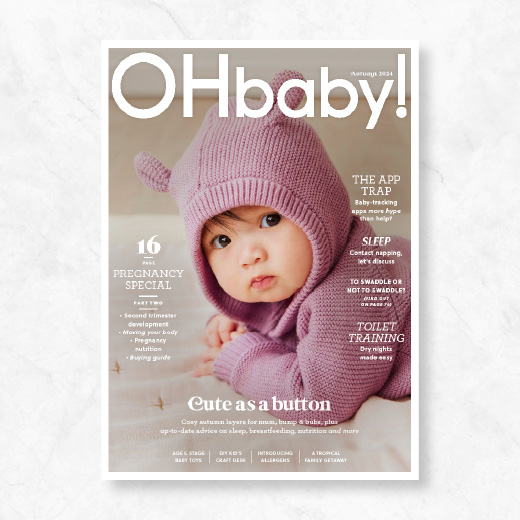Sleep expert gives us the lowdown on swaddling

Sleep and development educator, chiropractor and mama, Dr Ainslee gives us the lowdown on swaddling.
To swaddle or not to swaddle? Swaddling can be a contentious topic, many people have strong feelings that all babies should be swaddled, or alternatively, that babies should not be swaddled. I don’t have any hard and fast rules or opinions around swaddling for you, however, what I do have is the information so you can make an informed decision about whether swaddling is right for your baby. Swaddling is indeed optional, and not something that you must or mustn't do.
So let’s unpack the history of swaddling, why swaddling is used, what the guidelines suggest about swaddling and SIDS, and options on how to navigate that information.
WHAT IS SWADDLING?
Swaddling is an age-old practise that runs centuries deep within human society and is a part of many cultures around the world. For generations, swaddling has been commonly practised with newborns, and while the art and technique can vary between households and countries, the principle of swaddling remains the same, to wrap a baby up firmly in order to restrict arm movement and provide deep-pressure sensory input. Both of these things can help a baby settle faster into sleep, and sleep for longer periods of time. But, times are changing – we have more knowledge of brain and body development now, and there is a tide turning in the guidelines being given to parents about swaddling.
| "There is now evolving advice from research and infant professionals that suggests parents should not swaddle." |
Once upon a time, all infant experts recommended swaddling. There is now evolving advice from research and infant professionals that suggests parents should not swaddle. This is causing confusion for parents, especially those who were told to swaddle their firstborn, and now, a few years later, are being told that swaddling isn’t recommended.
SO, WHY HAS SWADDLING ADVICE SHIFTED?
The idea of swaddling is to help a baby settle into sleep easier and help them to stay asleep for longer. One of the reasons swaddling sometimes has this impact on babies is because it creates deep-pressure sensory feedback for the baby which is thought to simulate the womb. However, the primary reason is that swaddling inhibits the arms from being able to move away from the body.
When the arms move away from the body in a newborn it is called the startle response, or Moro reflex and this physical movement often wakes a baby from their slumber. The startle response is a physical reaction that involves the baby lifting their arms up away from their body, tilting their head back and often crying. Although depending on the degree of the startle response triggered the baby may not cry. For example, a baby may throw their hands and arms up, but not be startled enough to cry. Swaddling means their arms are kept by their body (whether it be by their heart, side or up by their head), which means this reaction can’t happen and therefore they are not startled awake.
For a long time the startle reflex was considered an annoyance and something that we wanted to dampen down so it couldn’t happen, which in theory, meant parents got more rest.
What we now know is that the startle response also illicits a physiological response that helps a baby take a sharp breath in and there is a thought pattern that this is one of the few inbuilt protective mechanisms babies have against SIDS, alongside many other influencing factors. Another protective mechanism against SIDS is waking regularly overnight for feeding, especially in those early months of life.
WHAT DO WE KNOW ABOUT SIDS AND SWADDLING?
The American Academy of Paediatrics states that there is no evidence to support swaddling decreases the risk of SIDS. This is relevant when the baby is placed on its back, however, we know that if a baby is swaddled and placed on its stomach, side or is bed sharing, then swaddling actually increases the risk of SIDS.
BENEFITS OF NOT SWADDLING
The startle response is a part of a series of primitive reflexes that babies are born with and it needs to be used regularly in the early months in order for it to integrate or 'disappear'. The only way through the startle response is by allowing it to happen. This means that in some ways, allowing the startle response to do its thing naturally in those early months (even if it might mean baby is more wakeful) will allow for more settled sleep once it is integrated. This approach could also prove beneficial timing-wise as a lot of parents don't stop swaddling their babies until they're around four months (around the time they start rolling) and the combination of learning to roll alongside finishing integrating the startle response, developing their circadian rhythm and changes to sleep architecture can all be factors that contribute to the four month sleep regression/progression that babies often experience. Removing the startle response as a cause of waking at this age by having it integrated earlier can be helpful. With that said, all reflexes integrate at their own pace, so some babies who are not swaddled will still have a significant startle response around four months of age.
ALTERNATIVES TO SWADDLING
It can be really handy to think of swaddling as another tool in your parenting toolbox to help with settling, rather than thinking of swaddling as something you do or don’t do. Some parents find they don’t need it during the day, but it is helpful during the evening to help with getting the baby off to sleep.
I would encourage parents to explore NOT swaddling from birth, or exploring this about a week after the baby has been born to see how it goes before they explore swaddling for ALL sleep.
Another alternative is swaddling with the baby’s arms out, but creating pressure around the torso, to give that snug feeling while leaving plenty of space around the hips to allow for hip safety.
If you choose to not swaddle your baby then using a newborn sized sleep sack made of natural fibres, where the arms are out and free, is a brilliant way to keep baby’s temperature regulated overnight.
| "Every baby is different, and some babies really need to be swaddled, especially in those early days to help calm their nervous system and help them sleep." |
WHAT IF YOUR BABY WON'T SLEEP WITHOUT SWADDLING?
That is okay, every baby is different, and some babies really need to be swaddled, especially in those early days to help calm their nervous system and help them sleep. This often comes down to the temperament and vagal tone of the baby. Roll with whatever works for you and your little one when it comes to swaddling.
Just make sure, if they are swaddled, that they are always slept on their back and not in a bed sharing situation (more on this in the safe swaddling section below). We can also do gentle movements during their wake time to help them integrate the startle response while awake, such as holding them horizontally and gently lowering their head lower than their bottom to illicit a small startle response a few times throughout the day.
| "The key here is education for parents, so they can make a call about what suits them and their baby." |
WHEN TO STOP SWADDLING, IF YOU DO SWADDLE?
There is a large bracket of suggested ages to stop swaddling. From the earlier, more conservative view that babies should not be swaddled after eight weeks of age (or at the earliest signs of rolling, whichever comes first), to stopping swaddling once your baby is rolling confidently which is often around four months.
The key here is education for parents, so they can make a call about what suits them and their baby. We know that some babies practise motor skills in the REM stage of sleep. This means some babies may roll in their sleep before they are doing it while awake.
MINISTONES
Keeping this in mind, it is important for parents to understand the smaller motor ‘ministones’ that indicate rolling is just around the corner. Awareness around what these smaller movements are allows parents to see that rolling is being worked on and remove the swaddle at an appropriate time, which is often well before they are rolling during the day confidently. These are:
Tummy to back ministones:
+ Pressing up on elbows and hands when on belly
+ Accidentally rolling off tummy when head throws them off balance
+ Attempting to grab toys with one hand
+ Lifting head high and looking around when head is up off the ground
Back to tummy ministones:
+ Rolling onto their side from being on their back
+ Grabbing their own feet
+ Grabbing feet and rocking over to one side or back and forth
+ Bringing hands to midline when they are on their side
+ Tucking chin to chest to look at feet
+ When lying on their side one leg straightens independently
WHAT FABRICS ARE BEST?
Natural fibers are best, where possible, to help regulate a baby’s body temperature. We know that synthetic fibers don’t breathe as well as natural ones and can be an overheating risk for babies while they sleep.
SWADDLE TYPES
There are so many different sorts of swaddles, it can be overwhelming for new parents. Different styles work for different babies. Options are: stretchy fabric wrap swaddles, muslin wrap swaddles, zip up swaddles, Velcro swaddles, and everything in between.
SWADDLING AND FEEDING
Babies need to utilise their feeding reflexes to be able to latch and feed well, so where possible, unswaddling for feeds is a good idea.
SAFE SWADDLING GUIDELINES
+ Always place a swaddled baby on their back, never on their side or stomach
+ Baby must be in their own sleep space and not bed sharing
+ Dress appropriately so they don’t overheat, weighted blankets and weighted swaddles are not recommended
+ Allow plenty of room around the hips so the hips can relax into a safe position
+ Swaddle in natural fibers to help regulate body temperature
+ Ensure the swaddle fits well and doesn’t cover airways, this is especially important if a baby wriggles free of a swaddle and ends up with fabric over their face, or they are in a zip up/Velcro swaddle that is too big and it moves up over their face while they sleep
In summary, swaddling is a practice that has been utilised for many generations and as always, when it comes to almost all things baby, there’s no clear cut do or don’t. Instead, I hope this article gives you as parents the understanding that swaddling can be used as a settling tool, rather than something you “just have to do” and will arm you with the information to decide if swaddling is something you want or need to use in your household and if so, to be able to do it in a safe way.
Dr Ainslee is a responsive infant sleep expert and chiropractor who focuses on holistic support and education for families. Follow her on Instagram @babysleepwithainslee or check out her website brainunderconstruction.co.nz.
Photo above: Ria Rawiri + Awhi company

AS FEATURED IN ISSUE 65 OF OHbaby! MAGAZINE. CHECK OUT OTHER ARTICLES IN THIS ISSUE BELOW

















